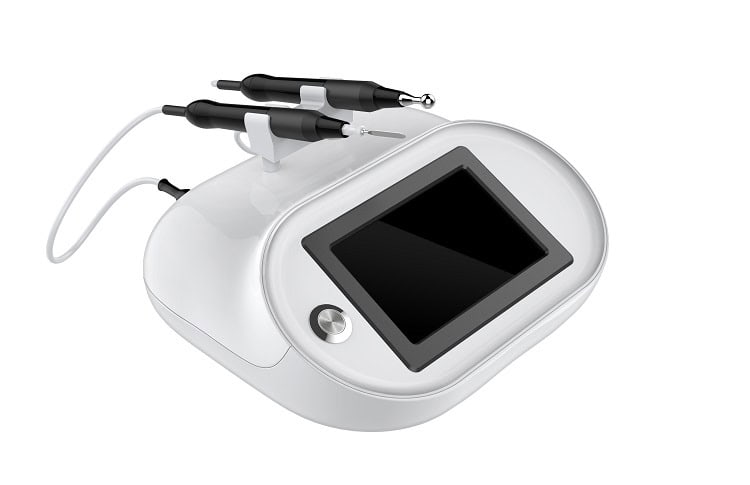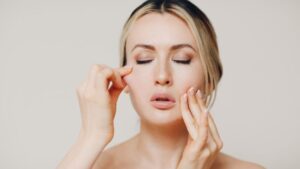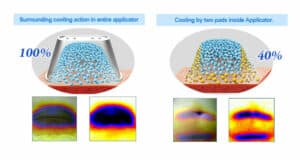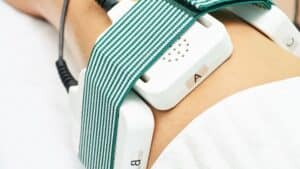Microcurrent and radio frequency are two popular cosmetic treatments that promise to rejuvenate the sagging skin and combat signs of aging.
While both technologies aim to improve skin appearance, they work in fundamentally different ways.
This article will explore the key differences between microcurrent and radio frequency treatments and their unique benefits, helping you determine which option might be better suited for your skincare goals.
What is Microcurrent Therapy?

Microcurrent therapy is a non-invasive treatment that applies weak electrical currents of less than 1 mA to specific areas of the body, particularly on the face.
The therapy aims to mimic the body’s natural electrical currents, which play a role in cellular processes and tissue repair. It is used as an anti-aging treatment to tighten and smooth facial muscles.
How Does Microcurrent Therapy Work?
The microcurrent stimulates facial muscles, causing them to contract. This “workout” for the face can help lift, tone, and firm the skin, potentially improving facial contours.
Microcurrent stimulates collagen and elastin production, which could help improve skin elasticity and reduce the appearance of fine lines.
Furthermore, microcurrents can increase the production of adenosine triphosphate (ATP), which enhances cellular energy and function and contributes to improved skin appearance and texture.
Electrical stimulation can also enhance blood circulation in the treated areas, potentially contributing to a healthier, more radiant complexion.
What are Microcurrent Devices?
The devices used in microcurrent are often small, handheld tools you can even use at home. Many come with conductive gels to improve the current flow.
These devices usually have two metal prongs or rollers. You glide them across your face in specific patterns. Some high-end models have preset programs for different areas of your face.
What is Radio Frequency Treatment?

Radio frequency treatment is also a non-invasive cosmetic procedure that uses energy waves to heat skin layers to tighten and rejuvenate the skin.
How Does Radio Frequency?
Radio Frequency (RF) treatments work by delivering controlled heat to the deeper layers of the skin using electromagnetic waves, which can penetrate the skin’s surface and reach the dermis layer.
As the RF energy encounters resistance in the skin tissue, it generates heat. This heat is typically raised to 122-167°F (50-75°C) in the deep dermis layer.
The controlled heat triggers a natural response in the skin, stimulating the production of new collagen and elastin fibers. This process is called collagen remodeling.
The heat causes an immediate contraction of existing collagen fibers, which can result in some instant tightening effects.
Over time, the newly produced collagen and elastin help improve skin structure, leading to firmer, tighter skin with improved texture.
What are the Components of a Radio Frequency Device?
Normally, an RF treatment device includes these parts: applicators, a cooling system, hand pieces, and an RF generator.
RF Generator is the core component that produces the radio frequency waves used in the treatment.
Applicators deliver the RF energy by contacting the skin. Depending on the treatment area, they can vary in size and shape.
Many RF devices incorporate a cooling mechanism to protect the skin’s surface while delivering heat to deeper layers.
The operator holds the hand piece, which often contains the electrodes and sometimes incorporates additional features like LED lights or suction.
What are the Differences Between Microcurrent and Radio Frequency Treatments?

| Aspect | Radiofrequency (RF) | Microcurrent |
| Mechanism | Uses radio waves to heat deeper skin layers | Uses low-level electrical currents |
| Target areas | Deeper skin layers | Facial muscles and surface skin cells |
| Primary benefits | Wrinkle reduction, skin tightening, texture improvement | Muscle lifting/toning, reducing puffiness, improving circulation |
| Results timeline | Gradual, over weeks to months | Often immediate, with long-term benefits from regular use |
| Sensation | Warming | Slight tingling |
| Treatment duration | 30-60 minutes | As short as 15 minutes |
| Skin type suitability | Most types, caution with sensitive skin | All types, including sensitive skin |
| Depth of penetration | Deeper | Surface and muscle level |
| Primary focus | Skin tightening and collagen production | Muscle toning and cellular stimulation |
| Longevity of results | Longer-lasting due to collagen stimulation | May require more frequent maintenance |
What are the Side Effects of Microcurrent and RF Treatments?
Microcurrent and radio frequency treatments have different safety considerations. Both can be safe when done correctly, but there are some risks to be aware of. Let’s look at the safety profiles for each.

Safety Considerations for Microcurrent
Microcurrent treatments are generally very safe. You likely won’t feel much during the procedure. Some people report a slight tingling sensation.
Side effects are rare and usually mild. You might see some redness that goes away quickly. In rare cases, you could have slight skin irritation.
It’s important to avoid microcurrent if you’re pregnant or have certain health conditions. These include epilepsy, heart problems, or metal implants.
Radio Frequency Risks
Radio frequency (RF) treatments can also be safe, but they have more potential risks than microcurrent.
During RF, you’ll feel the heat on your skin. This is normal, but it can be uncomfortable for some people.
Common side effects include temporary redness, swelling, and tingling. These usually go away within a few hours or days.
In rare cases, more serious side effects can happen. These might include burns, changes in skin color, or scarring.
Also, RF isn’t safe if you’re pregnant or have certain health issues. Don’t get RF if you have metal implants or active skin infections.
Frequently Asked Questions
Can microcurrent and radio frequency therapies be used together safely?
Yes, you can safely combine microcurrent and radiofrequency treatments. Many spas offer combo treatments, which may provide more complete facial rejuvenation.
Microcurrent can lift and tone muscles, while RF tightens skin. Together they can address multiple signs of aging. Just be sure to follow proper guidelines and don’t overdo it.
How do microcurrent therapies compare with radio frequency for reducing wrinkles?
Microcurrent facial treatment may help smooth fine lines by toning facial muscles, giving skin a lifted, firmer look. Radio frequency works more directly on wrinkles by stimulating collagen.
RF heat causes skin to contract, which can quickly reduce fine lines and wrinkles. However, microcurrent effects may last longer as muscles stay toned. Both can be good options, depending on your needs.
What benefits does microcurrent offer over radio frequency for neck treatments?
Microcurrent is great for neck treatments. It can help tone and lift neck muscles that sag with age. This may reduce the appearance of a “turkey neck” or double chin.
RF is also used on the neck to tighten the skin. But it doesn’t target muscles in the same way. For neck lifting and defining, microcurrent often gives better results.
Which is more effective for at-home use: microcurrent or radio frequency devices?
Both microcurrent and RF devices are available for home use. Microcurrent tends to be easier and safer to use at home. There’s less risk of burns or skin damage.
RF can be very effective but requires more skill. It’s easier to overdo RF treatments at home. For most people, microcurrent is a better choice for DIY facial treatments.
How do microcurrent treatments differ from high frequency and EMS procedures?
Microcurrent technologies use very low electrical currents to stimulate muscles. High-frequency uses a different type of current to kill bacteria and boost circulation. EMS (electrical muscle stimulation) uses stronger currents to cause muscle contractions.
Each works differently and has unique benefits. Microcurrent is best for gentle toning and lifting. High frequency helps with acne and skin healing. EMS is mainly used for muscle building and rehab, not skincare.






